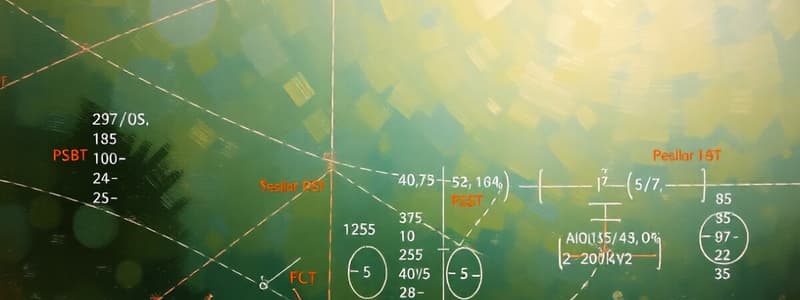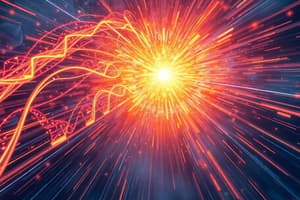Podcast
Questions and Answers
What did the gold foil experiment reveal about the structure of an atom?
What did the gold foil experiment reveal about the structure of an atom?
The gold foil experiment showed that most alpha particles passed straight through the foil, indicating that atoms are mostly empty space.
What is an ion, and how is it formed?
What is an ion, and how is it formed?
An ion is an electrically charged atom or group of atoms formed by the loss or gain of electrons.
What are the four ways to increase the electromotive force (emf) induced in a coil?
What are the four ways to increase the electromotive force (emf) induced in a coil?
Increasing the frequency of rotation, the number of turns on the coil, the strength of the magnet, and inserting a soft iron core.
Explain how a relay operates in an electrical circuit.
Explain how a relay operates in an electrical circuit.
Describe the mechanism by which an electric bell operates.
Describe the mechanism by which an electric bell operates.
What is the orientation of the magnetic poles in a solenoid based on current direction?
What is the orientation of the magnetic poles in a solenoid based on current direction?
What distinguishes a comet from an asteroid in the solar system?
What distinguishes a comet from an asteroid in the solar system?
How does gravitational attraction influence the orbital speed of planets?
How does gravitational attraction influence the orbital speed of planets?
What distinguishes a permanent magnet from an induced magnet?
What distinguishes a permanent magnet from an induced magnet?
List two methods for plotting magnetic fields.
List two methods for plotting magnetic fields.
What are the risks associated with damaged insulation of electrical wires?
What are the risks associated with damaged insulation of electrical wires?
Explain the function of the earth wire in an electrical circuit.
Explain the function of the earth wire in an electrical circuit.
What happens to the direction of induced current in relation to changes in a magnetic field?
What happens to the direction of induced current in relation to changes in a magnetic field?
What is the primary use of a trundle wheel in measurements?
What is the primary use of a trundle wheel in measurements?
Define electric field strength and explain its nature.
Define electric field strength and explain its nature.
What happens to the shape of a distance-time graph when an object is accelerating?
What happens to the shape of a distance-time graph when an object is accelerating?
How does air resistance affect falling objects?
How does air resistance affect falling objects?
What does it mean when we say mass resists change in motion?
What does it mean when we say mass resists change in motion?
Explain the concept of upthrust in fluids.
Explain the concept of upthrust in fluids.
How does friction relate to heat transfer?
How does friction relate to heat transfer?
What is thermal expansion and what causes it?
What is thermal expansion and what causes it?
Describe the relationship between pressure and depth in a column of water.
Describe the relationship between pressure and depth in a column of water.
What is the relationship between wavefront spacing and wavelength?
What is the relationship between wavefront spacing and wavelength?
How is the wavelength measured differently in transverse and longitudinal waves?
How is the wavelength measured differently in transverse and longitudinal waves?
What occurs to waves when they experience refraction as they pass into a denser medium?
What occurs to waves when they experience refraction as they pass into a denser medium?
Define total internal reflection (TIR) and explain when it occurs.
Define total internal reflection (TIR) and explain when it occurs.
What is the significance of the refractive index in relation to wave speed?
What is the significance of the refractive index in relation to wave speed?
Flashcards
Wavelength
Wavelength
The distance between two consecutive peaks of a transverse wave or two consecutive compressions of a longitudinal wave.
Frequency
Frequency
The number of waves passing a fixed point in one second.
Wave speed
Wave speed
The speed at which a wave travels through a medium.
Reflection
Reflection
Signup and view all the flashcards
Refraction
Refraction
Signup and view all the flashcards
Diffraction
Diffraction
Signup and view all the flashcards
Refractive index
Refractive index
Signup and view all the flashcards
Total Internal Reflection (TIR)
Total Internal Reflection (TIR)
Signup and view all the flashcards
Converging Lens
Converging Lens
Signup and view all the flashcards
Diverging Lens
Diverging Lens
Signup and view all the flashcards
Magnetic material
Magnetic material
Signup and view all the flashcards
Permanent magnet
Permanent magnet
Signup and view all the flashcards
Induced magnet
Induced magnet
Signup and view all the flashcards
Magnetic field
Magnetic field
Signup and view all the flashcards
Damaged insulation
Damaged insulation
Signup and view all the flashcards
Overheating cables
Overheating cables
Signup and view all the flashcards
Live wire
Live wire
Signup and view all the flashcards
Earth wire
Earth wire
Signup and view all the flashcards
Trundle Wheel
Trundle Wheel
Signup and view all the flashcards
Human Reaction Time
Human Reaction Time
Signup and view all the flashcards
Multiple Readings
Multiple Readings
Signup and view all the flashcards
Velocity
Velocity
Signup and view all the flashcards
Electric Field Strength
Electric Field Strength
Signup and view all the flashcards
Power
Power
Signup and view all the flashcards
Acceleration
Acceleration
Signup and view all the flashcards
Curved Distance Time Graph
Curved Distance Time Graph
Signup and view all the flashcards
Increasing Acceleration on Speed Time Graph
Increasing Acceleration on Speed Time Graph
Signup and view all the flashcards
Acceleration of Free Fall
Acceleration of Free Fall
Signup and view all the flashcards
Air Resistance
Air Resistance
Signup and view all the flashcards
Mass
Mass
Signup and view all the flashcards
Gravitational Field Strength
Gravitational Field Strength
Signup and view all the flashcards
Upthrust
Upthrust
Signup and view all the flashcards
Resultant Force
Resultant Force
Signup and view all the flashcards
Gold Foil Experiment: Alpha Particle Passage
Gold Foil Experiment: Alpha Particle Passage
Signup and view all the flashcards
Gold Foil Experiment: Alpha Particle Deflection
Gold Foil Experiment: Alpha Particle Deflection
Signup and view all the flashcards
Gold Foil Experiment: Alpha Particle Rebound
Gold Foil Experiment: Alpha Particle Rebound
Signup and view all the flashcards
What is an Ion?
What is an Ion?
Signup and view all the flashcards
What is Mass Number (A)?
What is Mass Number (A)?
Signup and view all the flashcards
What is Proton Number (Z)?
What is Proton Number (Z)?
Signup and view all the flashcards
What is Relative Charge?
What is Relative Charge?
Signup and view all the flashcards
What is Nuclear Charge?
What is Nuclear Charge?
Signup and view all the flashcards
How to increase a solenoid's magnetic field strength
How to increase a solenoid's magnetic field strength
Signup and view all the flashcards
What is a relay?
What is a relay?
Signup and view all the flashcards
How does an electric bell work?
How does an electric bell work?
Signup and view all the flashcards
How to determine the poles of a solenoid?
How to determine the poles of a solenoid?
Signup and view all the flashcards
When does a particle experience maximum force in a magnetic field?
When does a particle experience maximum force in a magnetic field?
Signup and view all the flashcards
How does a DC motor work?
How does a DC motor work?
Signup and view all the flashcards
How does the motor effect work in a loudspeaker?
How does the motor effect work in a loudspeaker?
Signup and view all the flashcards
How do transformers work?
How do transformers work?
Signup and view all the flashcards
Asteroids
Asteroids
Signup and view all the flashcards
Comets
Comets
Signup and view all the flashcards
Gravitational Attraction
Gravitational Attraction
Signup and view all the flashcards
Orbital Speed
Orbital Speed
Signup and view all the flashcards
Main Sequence Star
Main Sequence Star
Signup and view all the flashcards
Red Giant/Supergiant
Red Giant/Supergiant
Signup and view all the flashcards
Geostationary Orbit
Geostationary Orbit
Signup and view all the flashcards
Polar Orbit
Polar Orbit
Signup and view all the flashcards
Study Notes
Unit 1
- Trundle wheel used to measure lengths of tens of meters.
- Standard human reaction time is 0.25 seconds.
- Multiple readings reduce uncertainty and increase accuracy in measurements.
- Velocity is displacement per unit time/speed in a given direction.
- Electric field strength is a vector quantity.
- Power is a scalar quantity.
- Objects can change velocity by speeding up, slowing down, or changing direction.
- Acceleration graph (distance vs time) is a curved line.
- Increasing acceleration results in a curved speed vs time graph.
- In the absence of air resistance, all objects fall with the same acceleration regardless of mass (freefall acceleration).
- Objects falling through a vacuum never reach terminal velocity.
- Air resistance is a frictional force from collisions with air particles.
- Mass measures quantity of matter at rest.
- Mass resists changes in motion.
- Gravitational field strength is the force per unit mass in a gravitational field.
- Vernier caliper measures to 0.01 mm (up to 15 cm).
- Micrometer measures to 0.001 mm (up to 3 cm).
- Digital balance measures to 0.01 g.
- Pointer measures extension accurately from ruler.
- Upthrust is a force pushing upwards on objects immersed in fluids (float/sink).
Unit 2
- Substance state change only changes molecule energy.
- Brownian motion is random particle movement in liquids/gases.
- Molecules in gases are constantly in random zigzag motion at high speeds.
- Volume and pressure graph shows a downward curve/ negative correlation.
- Thermal expansion happens because molecules speed up and collide more often.
- Consequences of thermal expansion include buckling in tracks/bridges.
- Methods for reducing friction include smoothing and lubrication.
- Thermal expansion used in temperature-activated switches and thermometers (bimetallic strips).
- Internal energy is the total energy stored within a system by its particles.
- Temperature change within melting/boiling points causes energy to be used to overcome intermolecular forces.
- Evaporation occurs at all temperatures only at the surface of a liquid.
Unit 3
- Waves transfer energy without matter transfer.
- Wavefronts show waves from above (closer wavefronts-shorter wavelength).
- Wavelength is the distance between consecutive points on a wave.
- Frequency is the number of waves passing a point per second.
- Wave speed is the distance a wave travels per second.
- Reflection occurs when waves hit a boundary and do not pass through (same medium).
- Refraction occurs when waves pass through a boundary changing speed and direction.
- Diffraction is a spreading out of waves when passing through a narrow gap.
- Diffraction is most prominent when gap width is roughly equal to wave length.
- Optically denser objects have higher refractive indices.
- Refractive index is the ratio of speeds in different mediums.
- Total internal reflection (TIR) occurs when light travels from denser to rarer medium resulting in reflection only.
- Principal axis is a line passing through the center of a lens.
- Focal length is the distance from lens center to principal focus point.
- Focus point is where parallel rays intersect/converge.
- Converging/Convex lens focuses light (real images produced).
- Diverging lens disperses light (diminished/ virtual).
- Longitudinal waves produce parallel, draw lines.
Unit 4
- Magnetic materials are those that are attracted to magnets (iron, cobalt, nickel).
- Permanent magnets produce their own magnetic fields.
- An induced magnet temporarily becomes a magnet in a magnetic field.
- Magnetic fields are regions where magnetic poles experience a force.
- Methods to plot magnetic fields include using iron filings or plotting compasses.
Unit 5
- Gold foil experiment showed that atoms mainly contain empty space.
- Ions have gained/lost electrons (electrically charged atoms or group of atoms).
- The mass number is the total number of nucleons in an atom.
- The proton number is the number of protons in an atom.
- Fission is the splitting of a large, unstable nucleus into smaller nuclei.
- The products of fission move quickly.
Unit 6
- The solar system contains eight planets orbiting the Sun.
- Moons are natural satellites that orbit planets.
- Asteroids are rocky bodies and comets are icy bodies orbiting the sun.
- Gravity attracts larger masses and closer objects.
- Gravitational pull affects orbital speed (closer planets are faster).
- Nebulae are clouds of gas and dust where stars form.
- Stars' life cycles include main sequence, red giant, white dwarf, supernova, and neutron star/black hole stages.
- Geostationary orbits keep satellites above the same point on Earth.
- Polar orbits cover the entire Earth's surface.
- Redshift shows galaxies moving away from us (expanding universe).
- Light years measure distances in space.
Studying That Suits You
Use AI to generate personalized quizzes and flashcards to suit your learning preferences.




